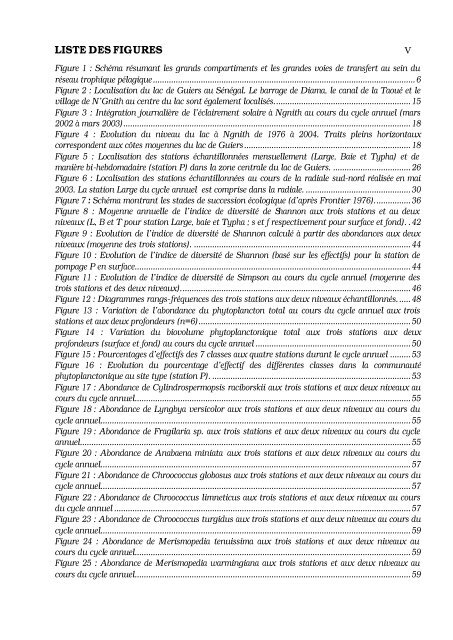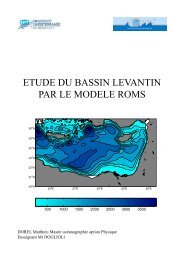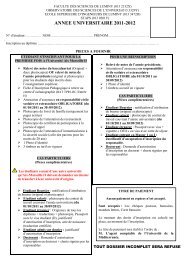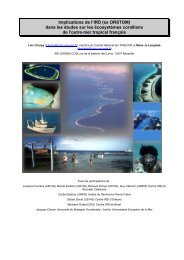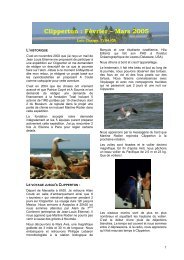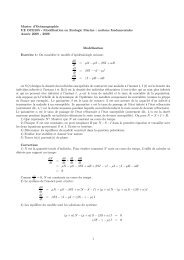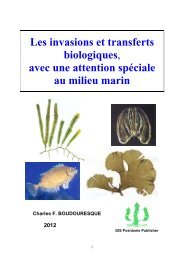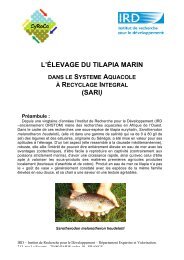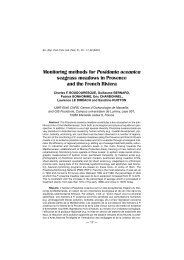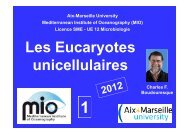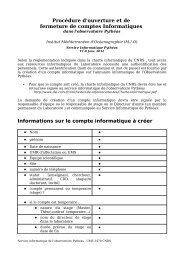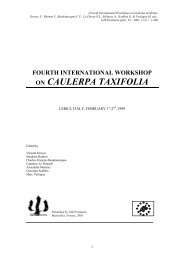Pour en savoir plus - Centre d'Océanologie de Marseille
Pour en savoir plus - Centre d'Océanologie de Marseille
Pour en savoir plus - Centre d'Océanologie de Marseille
You also want an ePaper? Increase the reach of your titles
YUMPU automatically turns print PDFs into web optimized ePapers that Google loves.
LISTE DES FIGURES V<br />
Figure 1 : Schéma résumant les grands compartim<strong>en</strong>ts et les gran<strong>de</strong>s voies <strong>de</strong> transfert au sein du<br />
réseau trophique pélagique...................................................................................................................6<br />
Figure 2 : Localisation du lac <strong>de</strong> Guiers au Sénégal. Le barrage <strong>de</strong> Diama, le canal <strong>de</strong> la Taoué et le<br />
village <strong>de</strong> N’Gnith au c<strong>en</strong>tre du lac sont égalem<strong>en</strong>t localisés............................................................15<br />
Figure 3 : Intégration journalière <strong>de</strong> l’éclairem<strong>en</strong>t solaire à Ngnith au cours du cycle annuel (mars<br />
2002 à mars 2003)..............................................................................................................................18<br />
Figure 4 : Evolution du niveau du lac à Ngnith <strong>de</strong> 1976 à 2004. Traits pleins horizontaux<br />
correspond<strong>en</strong>t aux côtes moy<strong>en</strong>nes du lac <strong>de</strong> Guiers.........................................................................18<br />
Figure 5 : Localisation <strong>de</strong>s stations échantillonnées m<strong>en</strong>suellem<strong>en</strong>t (Large, Baie et Typha) et <strong>de</strong><br />
manière bi-hebdomadaire (station P) dans la zone c<strong>en</strong>trale du lac <strong>de</strong> Guiers. ..................................26<br />
Figure 6 : Localisation <strong>de</strong>s stations échantillonnées au cours <strong>de</strong> la radiale sud-nord réalisée <strong>en</strong> mai<br />
2003. La station Large du cycle annuel est comprise dans la radiale. ..............................................30<br />
Figure 7 : Schéma montrant les sta<strong>de</strong>s <strong>de</strong> succession écologique (d’après Frontier 1976)................36<br />
Figure 8 : Moy<strong>en</strong>ne annuelle <strong>de</strong> l’indice <strong>de</strong> diversité <strong>de</strong> Shannon aux trois stations et au <strong>de</strong>ux<br />
niveaux (L, B et T pour station Large, baie et Typha ; s et f respectivem<strong>en</strong>t pour surface et fond). .42<br />
Figure 9 : Evolution <strong>de</strong> l’indice <strong>de</strong> diversité <strong>de</strong> Shannon calculé à partir <strong>de</strong>s abondances aux <strong>de</strong>ux<br />
niveaux (moy<strong>en</strong>ne <strong>de</strong>s trois stations). ...............................................................................................44<br />
Figure 10 : Evolution <strong>de</strong> l’indice <strong>de</strong> diversité <strong>de</strong> Shannon (basé sur les effectifs) pour la station <strong>de</strong><br />
pompage P <strong>en</strong> surface.........................................................................................................................44<br />
Figure 11 : Evolution <strong>de</strong> l’indice <strong>de</strong> diversité <strong>de</strong> Simpson au cours du cycle annuel (moy<strong>en</strong>ne <strong>de</strong>s<br />
trois stations et <strong>de</strong>s <strong>de</strong>ux niveaux).....................................................................................................46<br />
Figure 12 : Diagrammes rangs-fréqu<strong>en</strong>ces <strong>de</strong>s trois stations aux <strong>de</strong>ux niveaux échantillonnés......48<br />
Figure 13 : Variation <strong>de</strong> l’abondance du phytoplancton total au cours du cycle annuel aux trois<br />
stations et aux <strong>de</strong>ux profon<strong>de</strong>urs (n=6).............................................................................................50<br />
Figure 14 : Variation du biovolume phytoplanctonique total aux trois stations aux <strong>de</strong>ux<br />
profon<strong>de</strong>urs (surface et fond) au cours du cycle annuel ....................................................................50<br />
Figure 15 : <strong>Pour</strong>c<strong>en</strong>tages d’effectifs <strong>de</strong>s 7 classes aux quatre stations durant le cycle annuel .........53<br />
Figure 16 : Evolution du pourc<strong>en</strong>tage d’effectif <strong>de</strong>s différ<strong>en</strong>tes classes dans la communauté<br />
phytoplanctonique au site type (station P). .......................................................................................53<br />
Figure 17 : Abondance <strong>de</strong> Cylindrospermopsis raciborskii aux trois stations et aux <strong>de</strong>ux niveaux au<br />
cours du cycle annuel.........................................................................................................................55<br />
Figure 18 : Abondance <strong>de</strong> Lyngbya versicolor aux trois stations et aux <strong>de</strong>ux niveaux au cours du<br />
cycle annuel........................................................................................................................................55<br />
Figure 19 : Abondance <strong>de</strong> Fragilaria sp. aux trois stations et aux <strong>de</strong>ux niveaux au cours du cycle<br />
annuel.................................................................................................................................................55<br />
Figure 20 : Abondance <strong>de</strong> Anaba<strong>en</strong>a miniata aux trois stations et aux <strong>de</strong>ux niveaux au cours du<br />
cycle annuel........................................................................................................................................57<br />
Figure 21 : Abondance <strong>de</strong> Chroococcus globosus aux trois stations et aux <strong>de</strong>ux niveaux au cours du<br />
cycle annuel........................................................................................................................................57<br />
Figure 22 : Abondance <strong>de</strong> Chroococcus limneticus aux trois stations et aux <strong>de</strong>ux niveaux au cours<br />
du cycle annuel ..................................................................................................................................57<br />
Figure 23 : Abondance <strong>de</strong> Chroococcus turgidus aux trois stations et aux <strong>de</strong>ux niveaux au cours du<br />
cycle annuel........................................................................................................................................59<br />
Figure 24 : Abondance <strong>de</strong> Merismopedia t<strong>en</strong>uissima aux trois stations et aux <strong>de</strong>ux niveaux au<br />
cours du cycle annuel.........................................................................................................................59<br />
Figure 25 : Abondance <strong>de</strong> Merismopedia warmingiana aux trois stations et aux <strong>de</strong>ux niveaux au<br />
cours du cycle annuel.........................................................................................................................59


